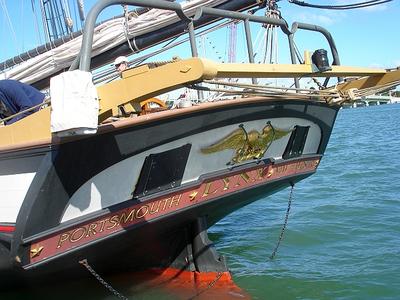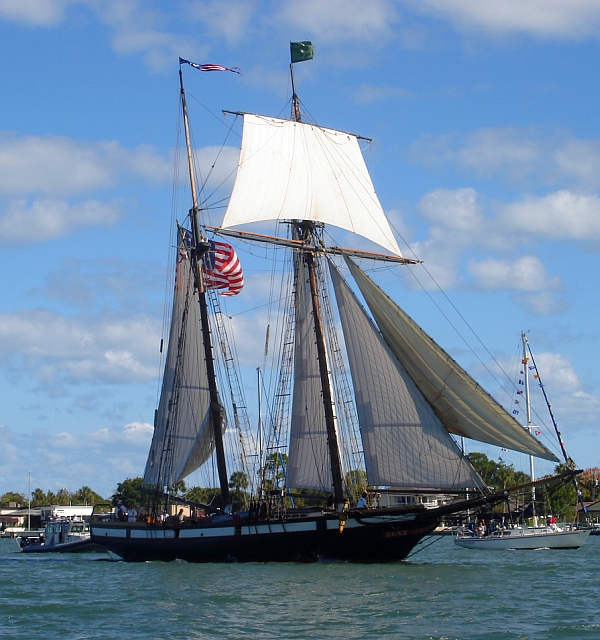
For 149 years no privateers attempted the St. Augustine Bar. Yesterday, that all changed. The Privateer Lynx, a topsail schooner, made her way safely through the inlet and secured her dock lines at St. Augustine Municipal Marina. Welcomed by a hearty throng of townspeople on land and by boat, the 122′ tallship saluted the city with broadsides from its carronades. Cutting through the gunpowder smoke and cheers, she made her way into our city to call it home for the next three months. LAMP was on hand to greet our sailing friends and celebrate the occasion.
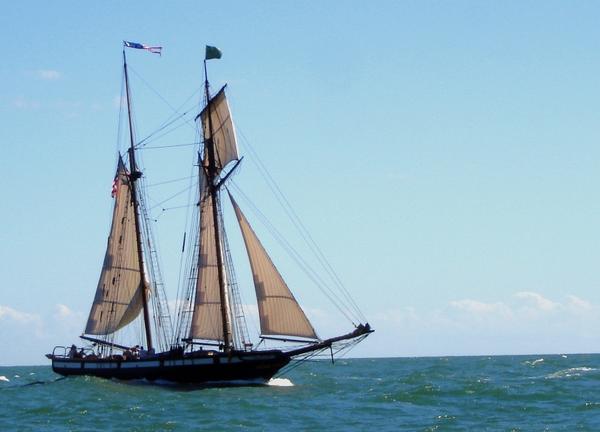
Two weeks ago Cpt. LeeAnne Gordon, captain of the Lynx, emailed us here at LAMP to ask about the inlet. NOAA charts of St. Augustine and its approaches are noticeably deficient on the bathymetry and nature of the inlet. Notes on the charts indicate that mariners unused to the inlet should refer to the coastal pilot and seek local knowledge. For hundreds of years the inlet has been a cantankerous piece of water, one that has swallowed many ships. Even when the inlet was affixed in its current location by the US Army Corps of Engineers in 1940 it still continues to need constant tending and maintenance to ensure safe passage for vessels. Boats routinely ground on the ebb shoals and require rescue and salvage by towing companies or passing fishermen. One would think that when you get past the jetties and ‘out to sea’, your troubles are over. Not true. Just outside our jetties the channel is ‘escorted’ closely by two shoals. These shallow areas not only can ground boats who stray but amplify wave energy and can, when conditions are unfavorable, turn the inlet into a washing machine. I’ve been onboard a 60′ pilot schooner which dipped its bowsprit two feet underwater in a semi-rough inlet. Just this past summer, when taking Roper out the inlet to work, we met a unusually large set of waves created by just the right conditions in the inlet and took the boat through the wave, rather than over it. Roper’s deckhouse roof stands about eight feet above the waterline and we took solid green water over the deckhouse!
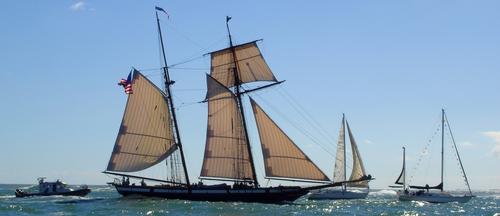
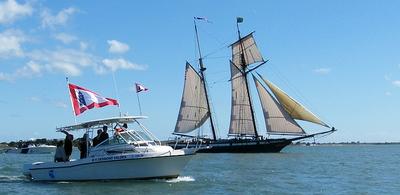
R/V Desmond Valdes, LAMP’s dive and survey vessel, escorting Lynx into the harbor.
And so when a vessel of significant draft enters our inlet for the first time, it is wise to check with locals to see what conditions are favorable for entry and where the shoals are located. I wrote up a set of sailing instructions for the Lynx, based on our observations from this summer’s field season as well as recent observations.
I had been on vacation for the days prior to Lynx’s arrival, fishing with friends off North Carolina’s infamous Cape Hatteras, also known as the ‘Graveyard of the Atlantic’. While I was up there, I stared out to sea and thought of Lynx, battling over the foam and clawing her way to our city. Rather, Cpt. Gordon advised me, they had a pretty easy go of it and only found whitecaps in the coffee off Cape Fear, NC. When I got back into town, I launched our survey and dive boat, the Desmond Valdes, to load our compliment of guests and crew. We motored out to the inlet and, slowly poking our nose out, saw Lynx in all her sailing splendor. Topsail set, she struck quite the image. Its not often we get to see such a visage of a replica 1812 War vessel standing in for St. Augustine.
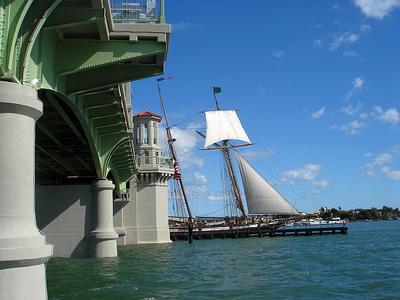
With her topsail backed and mainsail scandalized, the schooner idled, waiting for the appointed time of tide and welcome. And soon the moment arrived, she came smartly to starboard and wheeled about for the inlet. The profusion of welcoming vessels almost made it seem as though St. Augustine had dumped extra boats into the water so as to raise the tide over the bar for safe passage. But each boat fell into step and with Lynx setting the pace, we glided with the rollers into the inlet, over the bar, and safely into the waters of Matanzas Bay. Following ancient traditions of the sea, Lynx issued a volley from her carronades to salute our fort and flag. Each shot was answered likewise from nearby vessels and shore-based piratical rogues. Lynx pirouetted in front of the fort to douse her sails and prepare for arrival. The crew could be seen readying dock lines, manning the halyards, and otherwise squaring-away the rig. Under power from her ‘D-sail’ (Caterpillar diesel engine) Lynx shot through the Bridge of Lions, turned, and sidled up to the dock. A good many folks had arrived to see her docking and the floating dock at the end of the marina was veritably awash with the admiring throng.
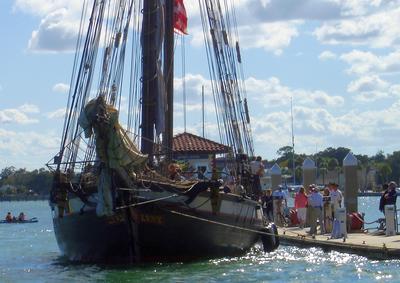
Lynx docking.
We are happy to have Lynx here in St. Augustine. She is a faithful replica of a privateering vessel built for service during the War of 1812. Read more about her history here at her website: www.privateerlynx.org
She represents a class of vessels that are built to educate, inspire, and carry on our nation’s proud history of seafaring. St. Augustine was visited by one of the sister ships to the original Lynx. During the Patriot’s War of 1812, also known by scholars as the ‘Other War of 1812’, two armed schooners named the Nonsuch and Hornet patroled the waters off os St. Augustine, as predators to Spanish shipping. St. Augustine’s municial frigate, at anchor and guarding the inlet on the outside, was ravaged by the Nonsuch in August of 1812. While they could take no prizes due to political complications, these Baltimore topsail schooners, known as Baltimore Clippers, were speedy and dangerous. The Lynx reminds us here of a little-discussed past. Welcome Lynx!
(PS-Be sure to enjoy a view of Lynx at her dock from the top of the St. Augustine Lighthouse.)
